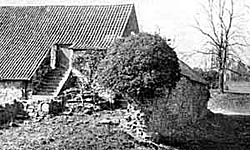< Previous | Contents | Next >
Greasley Castle
 |
GREASLEY CASTLE is not really a castle at all, but a fortified manor house. A castle is properly a fortress erected for the protection of an invading force in the midst of a hostile population, and the conditions under which Greasley was fortified do not fit in with that definition at all.
The Greasley estates passed by marriage into the hands of the great Cantalupe family in the late thirteenth century, and a century or so later one of the Cantalupes founded Beauvale Abbey.
The name of this man was Nicholas Cantalupe, and he was an intimate friend of Edward III. Life was very hectic in those days. When Edward was not busy with his Scottish wars he was occupied with his French wars.
The terrible plague known as the Black Death was soon to visit the land, killing off so large a proportion of the population that the economic conditions of the country were broken down, and the land was filled with savage wanderers, inured to warfare, and thinking nothing of murder or robbery. Moreover, there was no effective police, and everybody must defend his own life and chattels.
Small wonder, then, that owners of estates obtained leave to fortify their houses so that they could protect themselves and their families against these desperadoes.
Nicholas Cantalupe received permission to fortify Greasley in 1341, just before the battle of Nevilles Cross, and when the fear of a Scottish invasion was strong in the land. The remains of his fortification remain, but are so masked by later farm buildings that they are difficult to understand.
Excavation carried out recently seems to point to the fact that Greasley was a square enclosure consisting of angle towers joined together by curtain walls, the whole being surrounded by a moat.
Here and there throughout the farm buildings are odd windows and architectural fragments which are hard to explain, but which it is to be hoped will gradually, as the study of the building progresses, be found to represent the great ball and other domestic buildings of the Cantalupes.
